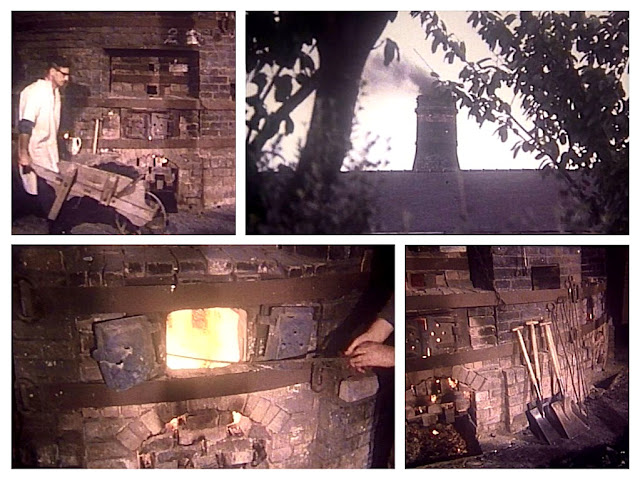What happened in the final firing?
From a contemporary report by Pam Bott
The Last Bottle Oven Firing in the Potteries began on Saturday 26 August 1978. But, for the organising committee, preparations began many months before.
The bottle ovens at Gladstone Pottery Museum were too fragile for the firing so the bottle oven chosen for the event was just a ten-minute walk away in the working factor of Hudson & Middleton Ltd. Extra precautions had to be taken to prevent any dirt and dust from spreading from all the activity during the cleaning up period to the production area.
A great deal of pigeon droppings had to be removed (the exact tonnage had not yet been worked out!) Volunteer members of the committee and 'volunteers' from the local Detention Centre worked several weekends cleaning the oven and the area around it, repairing various parts of it, and erecting screens to protect the factory.
 |
| Gladstone Pottery Museum - Last Bottle Oven Firing 1978 The updraught, skeleton type, bottle oven at the Sutherland Works of Hudson and Middleton (Longton) Ltd |
Meetings with the placers were arranged and volunteer recruitment was organised. Last minute work at 10pm on Friday August 25th 1978 included erecting barriers and displays, painting the shelters for the turnstile attendants and putting up notices and directions. As this was in those days before laptops and printers I wrote all the signs and posters by hand.
Twelve hours later the public were streaming in and for many people a week of nostalgia began. It is interesting to note that during the firing more local people visited the museum than on any other occasion.
The placers, none of whom had met or worked together before, merged into a well-organised team in less than an hour. The placing of the oven was spread over three days and apart from a few minor hitches everything went according to plan and the oven was filled late on Monday afternoon. A cheer went up and the team of men, who had been laughing and joking throughout the three days, finished the day off with a song.
 |
| Gladstone Pottery Museum - Last Bottle Oven Firing 1978 Photos: Ken Davis |
On Tuesday morning the clammins was built up and covered by local bricklayer, Billy Ryan, and after a slight delay the 8 firemouths were ready to be lit.
 |
| Gladstone Pottery Museum - Last Bottle Oven Firing 1978 Billy Ryan building the clammins Photo: Staffordshire Past Track here> |
It was left to members of the committee to kindle a fire each, starting with me, Pam Bott, and ending with fireman Mr. Alfred Clough's grandson, Alistair. Black smoke once more belched out over Longton much to the excitement and appreciation of all those present.
The responsibility of the night firing was taken by the sitter-up fireman, Jack Hill, who had a team of energetic volunteers to do all the baiting. There were a few people who gathered to stay up throughout the night but most of them did not manage to keep awake for long.
 |
| Gladstone Pottery Museum - Last Bottle Oven Firing 1978 |
One of the debatable points of the week was whether the band of people gathered around the oven at 6am on Wednesday morning were there out of sheer enthusiasm or just to sample the bacon which was cooked on a shovel over the fires. The smell was delicious and the sizzling so spectacular that it has been recorded by the BBC sound archives!
 |
| Gladstone Pottery Museum - Last Bottle Oven Firing 1978 Les Dennis, volunteer, cooks breakfast on a British Standard No.8 shovel Notice the heat in the oven - well advanced Photo: Brian Colclough |
 |
Gladstone Pottery Museum - Last Bottle Oven Firing 1978
Dr Francis Celoria has a go cooking his bacon on a shovel!
Photo: Brian Colclough |
Shifts changed over on Wednesday morning and Mr. Clough took over once more. After several baitings throughout the day, and the taking of trials, he announced the firing finished at 7.30pm on Wednesday night. ‘Firing done! Open all the dampers’ he declared.
For the next two hours nothing was done to the oven at all. Some of us took the opportunity to walk up Uttoxeter Road to the local pub, The Sailor Boy, to quench our thirsts while the fires were left to gradually burn out.
At about 10pm the clammins was brought down. A brilliant glowing orange was revealed. Breaking down the clammins proved to be the most spectacular part of the firing, not only for the excitement as everyone waited to see inside, but also because we had forgotten to check if there was anything inflammable nearby. The result was that several cables smouldered and melted causing temporary loss of light.
For the next two days the oven was left to cool, even so there was still some warmth left in the firemouths on Saturday morning. The ware was drawn from the oven, most of it having fired perfectly. At 4pm on Saturday 2nd September 1978 the cycle of firing was complete.
Throughout the week a film of events was made for the museum by the University of Aston; a film was made by the local education authority; slide photos were taken by several of our volunteers and a complete log of events was tape recorded by volunteer Terry Woolliscroft.
The ware from the oven was put on sale at Gladstone Pottery Museum two weeks after the firing and this resulted in large queues forming with some customers even camping out the previous night.
After the firing the whole Hudson and Middleton factory had to be cleaned. It was hoovered from top to bottom, even the bottle oven!

